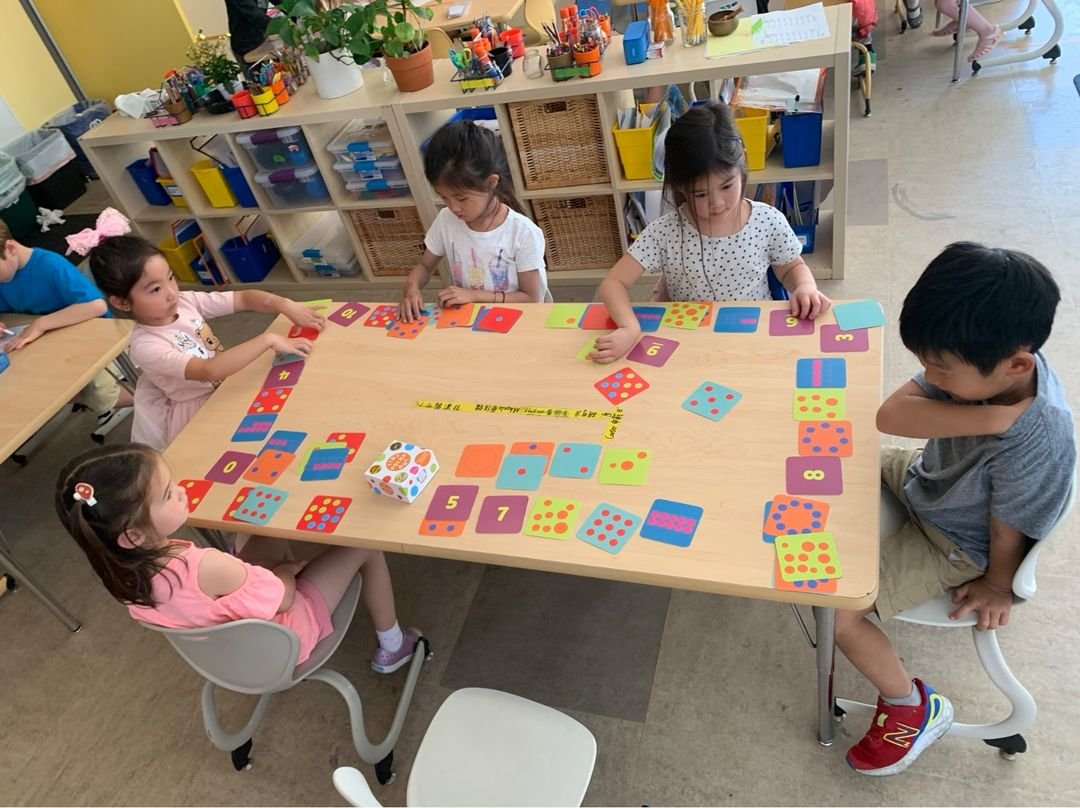Elementary Deep Dives
Math in Kindergarten
The Big Picture: Teaching and Learning Math in Elementary School
Embracing an innovative approach to math education, PKS integrates the Bridges curriculum with open-ended math investigations related to our Units of Exploration. This blended method not only ensures differentiation but also challenges students to think deeply about math concepts across different contexts. By intertwining structured learning with real-world application, we foster an engaging and inviting math environment that naturally fosters both foundational skills and deeper critical thinking.
Central to our math program are six big ideas that frame student learning across the elementary continuum from kindergarten through fourth grade:
Students explore composing and decomposing numbers, both conceptually and in practice, gaining a deep understanding of operations.
Students engage with visual representations of mathematical concepts, developing a strong grasp of how not only numbers, but also ideas and relationships can be represented visually.
Students learn to use and understand mathematical tools and pictures, enhancing their problem-solving abilities.
Students learn to look for and see patterns, creating deeper ways to understand numbers and make sense of the world.
Students practice describing, sorting, and categorizing, applying analytical skills through creative lenses.
Students use numbers in the context of measurement to obtain information, make comparisons, and solve problems in the real world context.
Our approach to teaching and learning math creates an engagement, excitement and energy that counters the myth of the 'math person'. At PKS, math isn’t just about numbers; it is an open invitation to all students to explore, and a gateway to making sense of the world through the lenses of numbers, relationships and patterns.
Zooming In: What Math Looks, Sounds and Feels Like in Kindergarten
Math is visual
Students love playing Tiny Polka Dot because it's fun! Teachers love this game because it fosters visual connections between amount and integer value, and it leads to interesting conversations.
Math is interactive
Throughout our elementary program, we learn math together, in pairs or small groups, to deepen engagement, flexible thinking, and communication skills.
In our lively kindergarten classrooms, we are deeply immersed in the world of mathematics, looking for and finding numbers, shapes and patterns in our environment. Number sense and patterns form the cornerstone of our exploration this year. Our recent focus has been on understanding combinations of five, a foundational concept that lays the groundwork for more complex numerical relationships. We're guiding our young learners towards a deeper comprehension of numbers, steadily moving towards understanding the intricate relationships within the realm of ten.
Central to our approach is not just teaching these concepts, but instilling a sense of excitement and wonder about math in every young learner. Through hands-on activities and interactive learning experiences, we're nurturing a genuine and shared passion for numbers and patterns. By cultivating this enthusiasm, we're not just teaching computational skills, we're shaping confident, creative and curious thinkers.
What do you notice?
What patterns are hidden within this calendar? Every month we explore a new set of images on our calendar, and start with the questions, “What do you see,” and “What do you notice?” We are amazed by the discussions that these questions ignite, and by the multiple and varied insights our students come to. What do you notice here?
Faculty Spotlight: Yang Cao, Math Curriculum Lead
Math has been a journey for me! Back in school, I used to view math as this daunting task of endless numbers and equations, just drills and formulas. But as I got older, I started seeing it as this incredible puzzle, a game waiting to be played. Solving a challenging math problem became like cracking a secret code, and suddenly, I was hooked. Now, as a teacher, I get to share this newfound excitement with my students. I love those 'aha' moments, you know, when they go from total confusion to that light in their eyes when it finally clicks.
One of my favorite things is turning math into a game. I get such a kick out of kids wanting to challenge me, and trust me, they often win! We play and learn together, making math this fun, interactive experience. Seeing their faces light up with pride when they solve a problem, it's like witnessing magic happen right in the classroom. And it's not just about numbers; it's about understanding the world around us. From measuring ingredients for a recipe to figuring out the best deals during sales, math is everywhere, and it's pretty cool once you get the hang of it!





